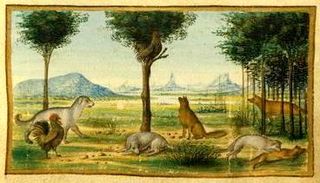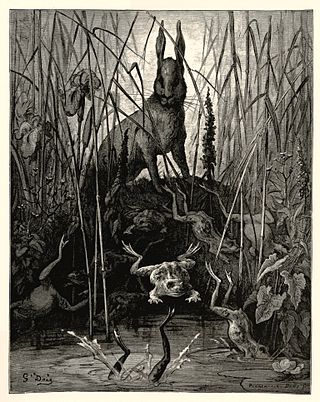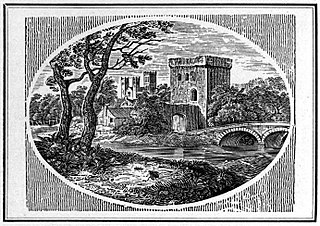
Aesop's Fables, or the Aesopica, is a collection of fables credited to Aesop, a slave and storyteller who lived in ancient Greece between 620 and 564 BCE. Of varied and unclear origins, the stories associated with his name have descended to modern times through a number of sources and continue to be reinterpreted in different verbal registers and in popular as well as artistic media.

The Boy Who Cried Wolf is one of Aesop's Fables, numbered 210 in the Perry Index. From it is derived the English idiom "to cry wolf", defined as "to give a false alarm" in Brewer's Dictionary of Phrase and Fable and glossed by the Oxford English Dictionary as meaning to make false claims, with the result that subsequent true claims are disbelieved.

"The Tortoise and the Hare" is one of Aesop's Fables and is numbered 226 in the Perry Index. The account of a race between unequal partners has attracted conflicting interpretations. The fable itself is a variant of a common folktale theme in which ingenuity and trickery are employed to overcome a stronger opponent.

The Fox and the Grapes is one of Aesop's Fables, numbered 15 in the Perry Index. The narration is concise and subsequent retellings have often been equally so. The story concerns a fox that tries to eat grapes from a vine but cannot reach them. Rather than admit defeat, he states they are undesirable. The expression "sour grapes" originated from this fable.

The Frog and the Ox appears among Aesop's Fables and is numbered 376 in the Perry Index. The story concerns a frog that tries to inflate itself to the size of an ox, but bursts in the attempt. It has usually been applied to socio-economic relations.
The story and metaphor of The Dog in the Manger derives from an old Greek fable which has been transmitted in several different versions. Interpreted variously over the centuries, the metaphor is now used to speak of one who spitefully prevents others from having something for which one has no use. Although the story was ascribed to Aesop's Fables in the 15th century, there is no ancient source that does so.
The Miser and his Gold is one of Aesop's Fables that deals directly with human weaknesses, in this case the wrong use of possessions. Since this is a story dealing only with humans, it allows the point to be made directly through the medium of speech rather than be surmised from the situation. It is numbered 225 in the Perry Index.
The lion's share is an idiomatic expression which now refers to the major share of something. The phrase derives from the plot of a number of fables ascribed to Aesop and is used here as their generic title. There are two main types of story, which exist in several different versions. Other fables exist in the East that feature division of prey in such a way that the divider gains the greater part - or even the whole. In English the phrase used in the sense of nearly all only appeared at the end of the 18th century; the French equivalent, le partage du lion, is recorded from the start of that century, following La Fontaine's version of the fable.

The Dog and Its Reflection is one of Aesop's Fables and is numbered 133 in the Perry Index. The Greek language original was retold in Latin and in this way was spread across Europe, teaching the lesson to be contented with what one has and not to relinquish substance for shadow. There also exist Indian variants of the story. The morals at the end of the fable have provided both English and French with proverbs and the story has been applied to a variety of social situations.

The Tortoise and the Birds is a fable of probable folk origin, early versions of which are found in both India and Greece. There are also African variants. The moral lessons to be learned from these differ and depend on the context in which they are told.

Aesop is an almost certainly legendary Greek fabulist and storyteller, said to have lived c. 620–564 BCE, and credited with a number of fables now collectively known as Aesop's Fables. Although his existence remains unclear and no writings by him survive, numerous tales credited to him were gathered across the centuries and in many languages in a storytelling tradition that continues to this day. Many of the tales associated with him are characterized by anthropomorphic animal characters.

The Cock, the Dog and the Fox is one of Aesop's Fables and appears as number 252 in the Perry Index. Although it has similarities with other fables where a predator flatters a bird, such as The Fox and the Crow and Chanticleer and the Fox, in this one the cock is the victor rather than victim. There are also Eastern variants of this story.
The Hawk and the Nightingale is one of the earliest fables recorded in Greek and there have been many variations on the story since Classical times. The original version is numbered 4 in the Perry Index and the later Aesop version, sometimes going under the title "The Hawk, the Nightingale and the Birdcatcher", is numbered 567. The stories began as a reflection on the arbitrary use of power and eventually shifted to being a lesson in the wise use of resources.

The Fox and the Lion is one of Aesop's Fables and represents a comedy of manners. It is number 10 in the Perry Index.

The Fox and the Weasel is a title used to cover a complex of fables in which a number of other animals figure in a story with the same basic situation involving the unfortunate effects of greed. Of Greek origin, it is counted as one of Aesop's Fables and is numbered 24 in the Perry Index.
The Fox and the Mask is one of Aesop's Fables, of which there are both Greek and Latin variants. It is numbered 27 in the Perry Index.

The Ape and the Fox is a fable credited to Aesop and is numbered 81 in the Perry Index. However, the story goes back before Aesop's time and an alternative variant may even be of Asian origin.

Hares are proverbially timid and a number of fables have been based on this behaviour. The best known, often titled "The Hares and the Frogs", appears among Aesop's Fables and is numbered 138 in the Perry Index. As well as having an Asian analogue, there have been variant versions over the centuries.

The Fly and the Ant is one of Aesop's Fables that appears in the form of a debate between the two insects. It is numbered 521 in the Perry Index.
The Frog and the Fox is one of Aesop's Fables and is numbered 289 in the Perry Index. It takes the form of a humorous anecdote told against quack doctors.














